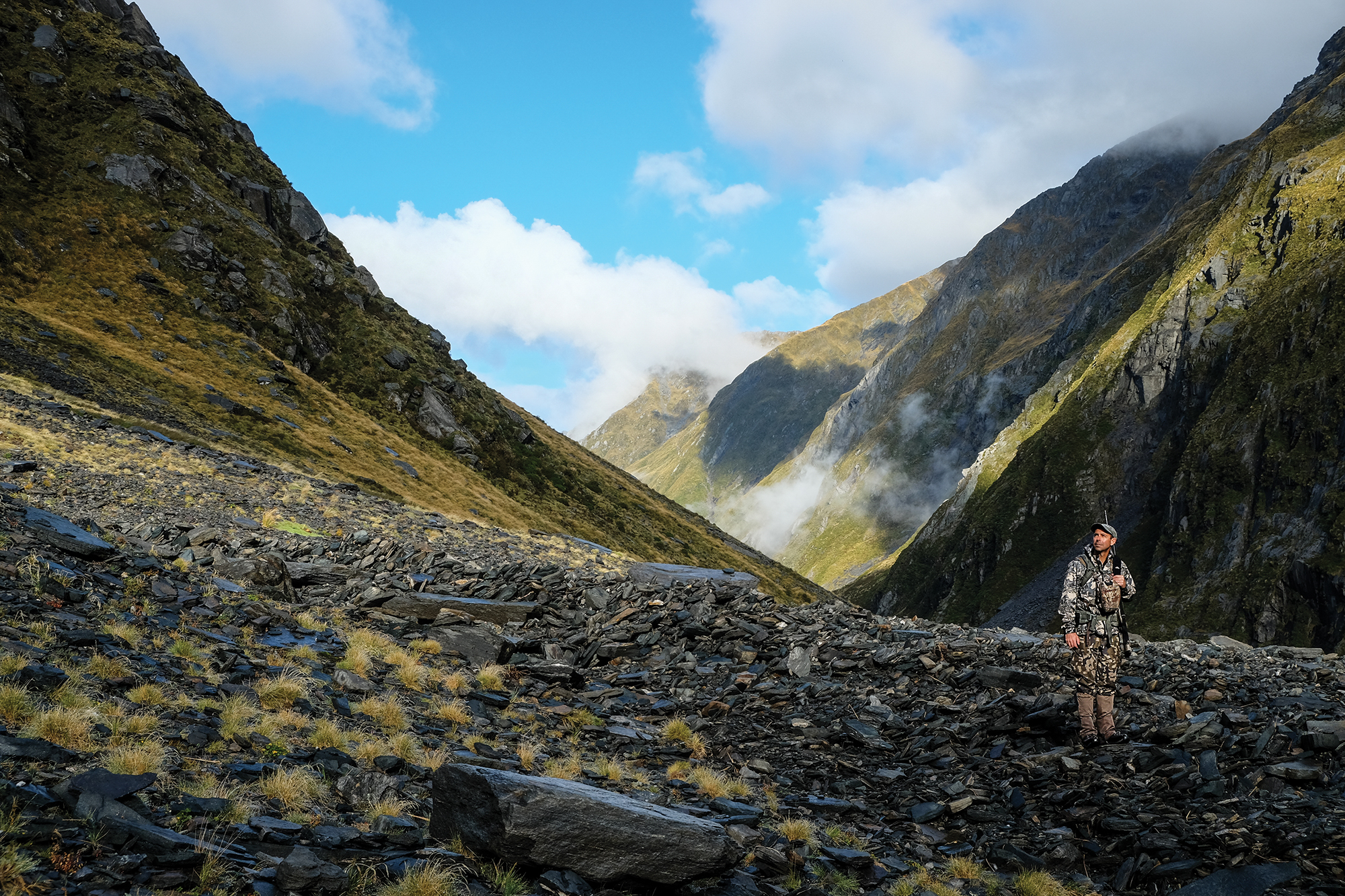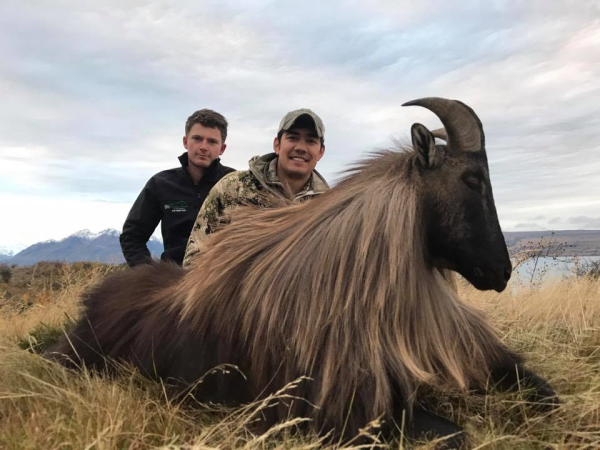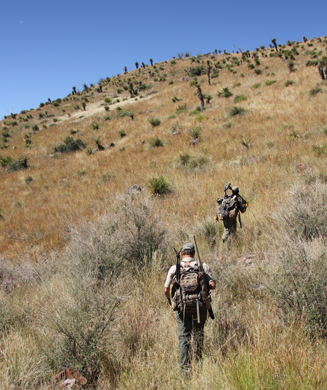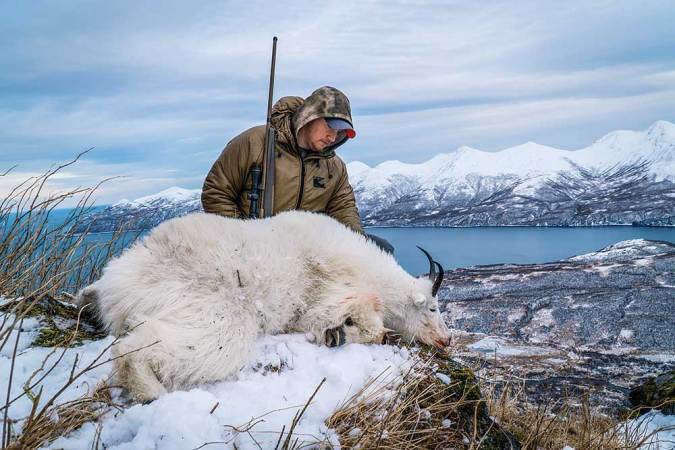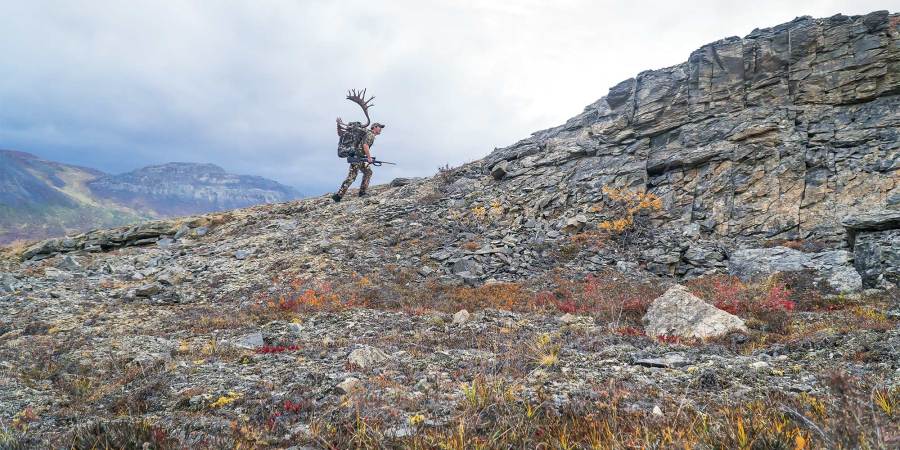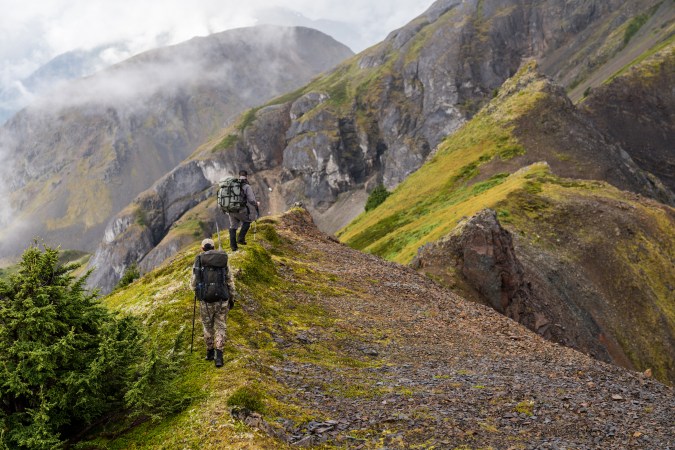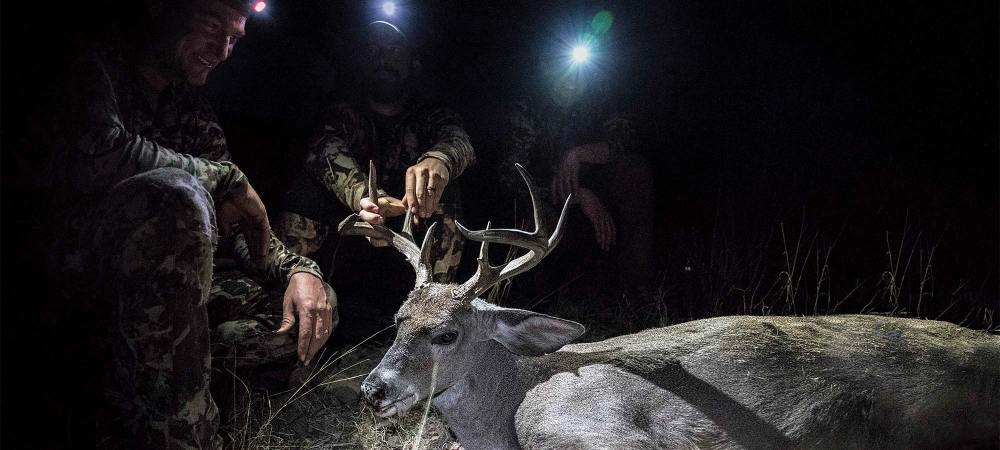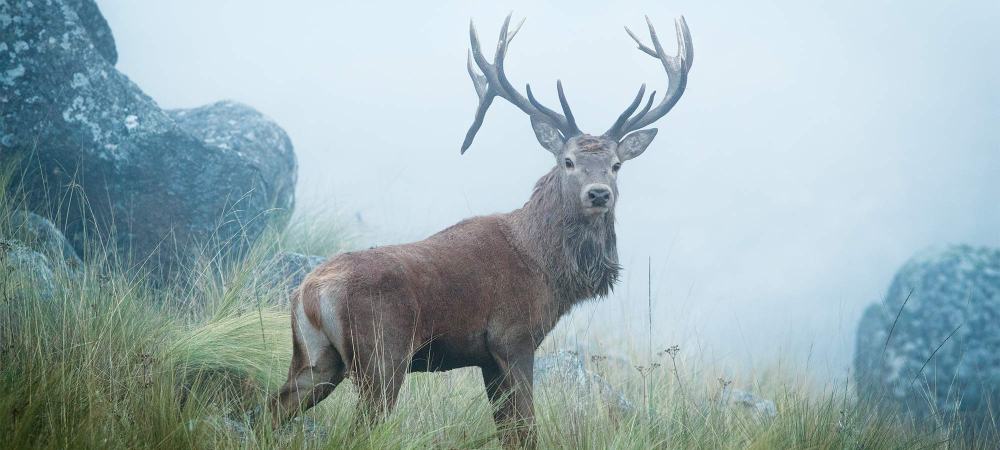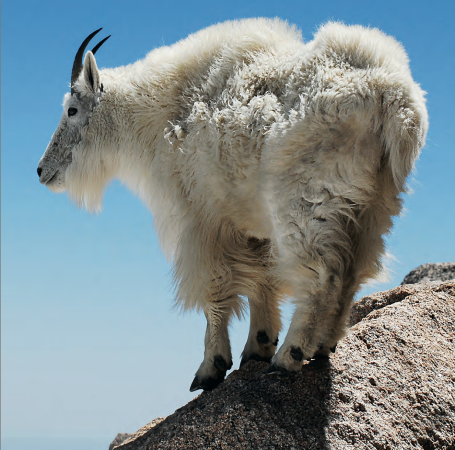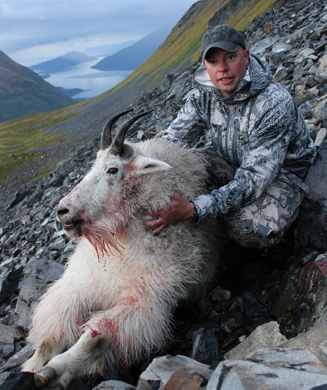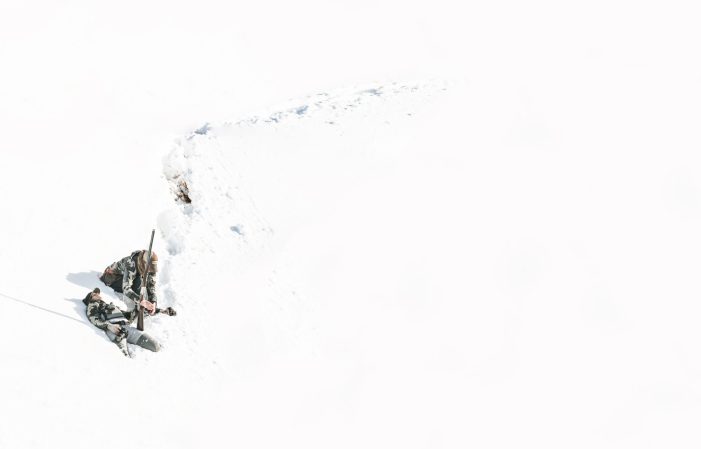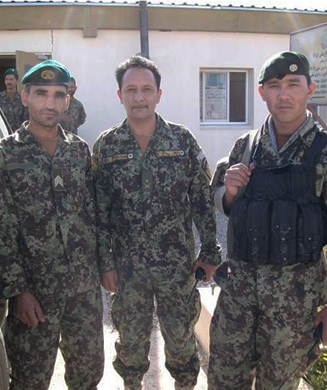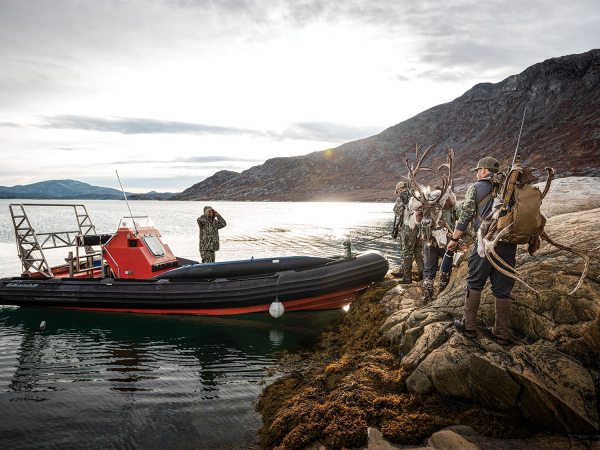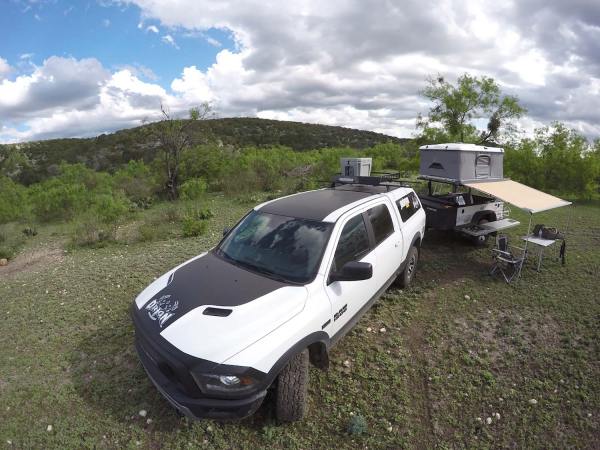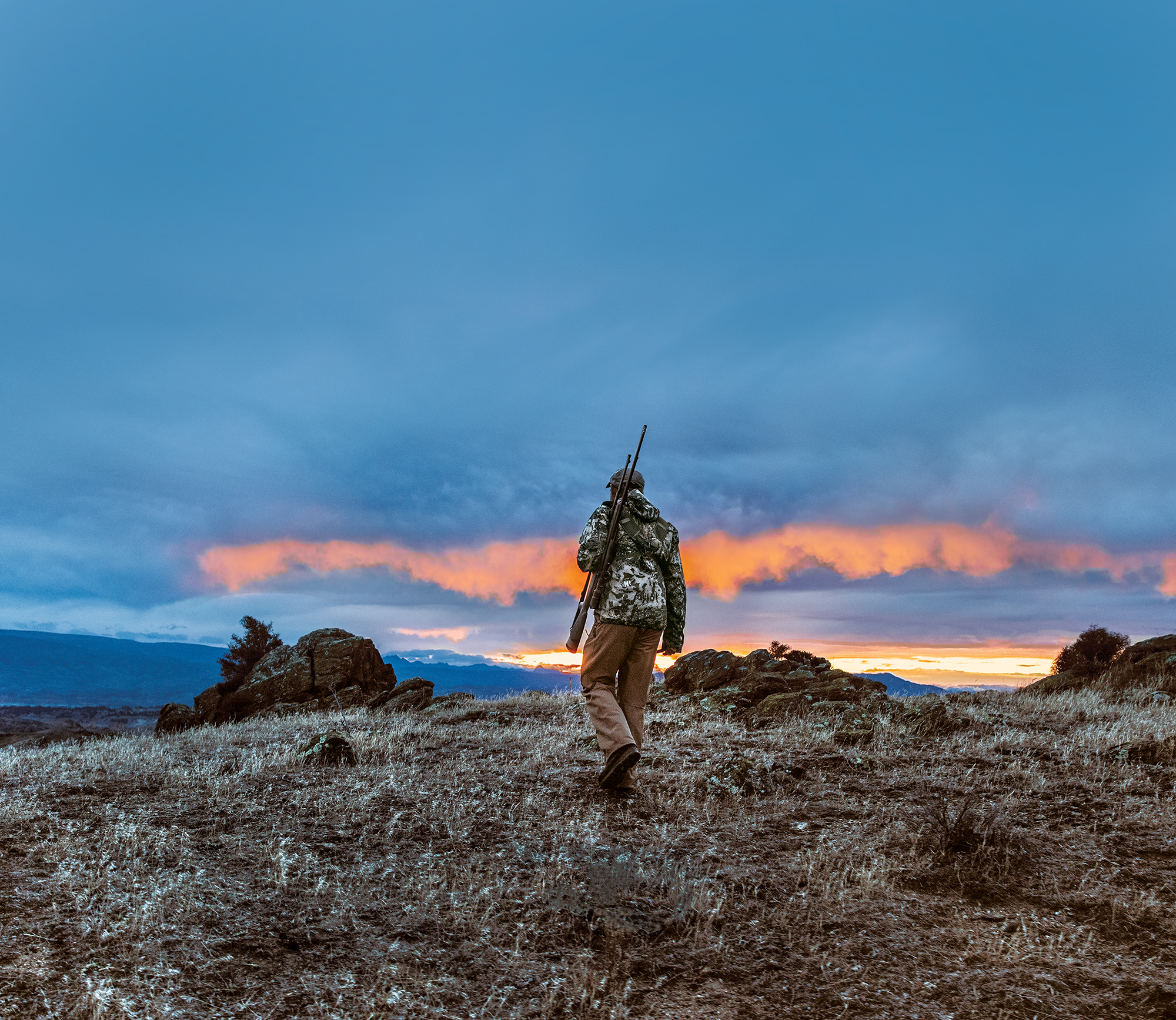
Above me—way above me, nearly at the skytop crest of this jagged mountain in New Zealand’s Southern Alps—a shaggy animal moves out of the deepening shadows of a vertical gneiss chute. I can just make out stocky horns through my binocular. It’s a tahr, a wild goat native to the Himalayas, and this one is a big, blocky bull with a flowing charcoal coat. He’s exactly what I’m after. I scan the mountain, bathed in the golden light of an alpine evening, looking for a route through headwalls and boulder fields that might get me close enough to him for a shot.
I’m mentally preparing for a black-night pack-out in the shattering steep, wondering how much juice is in my headlamp batteries and how much of the bull I can carry in my pack. I recall the words of our guide, Phil Wilson: “In the dark, the only safe way down is the way you went up,” because alternate descents often end in cliffs. Then my buddy, Ben O’Brien, shifts his torso. We’re leaning against each other, back-to-back in the grass below the alpine cirque, and Ben has been glassing a cliff face behind me. He whispers a single, exotic phrase: “Sham-wah.”
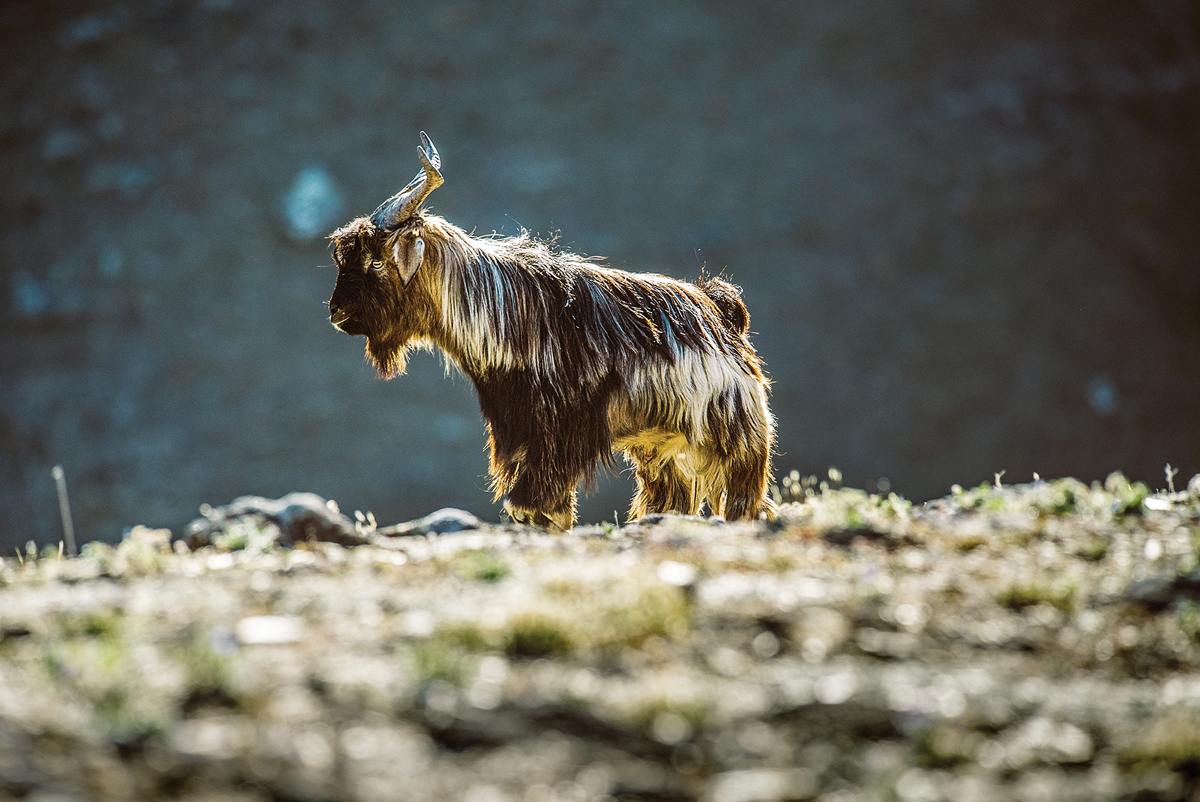
LOW-FENCE SAFARI
Mountain hunters are attracted to each other by shared experience, but it’s a restless fellowship. We don’t like to share our best spots, and we are happiest hunting alone. But listen to alpinists long enough, and a few places continually crop up in conversation: the Brooks Range of Alaska, Kyrgyzstan, Nevada’s Ruby Range. The Wind River Range. And New Zealand.
I suppose it was just a matter of time before I hunted the island nation myself, but I wasn’t prepared for what I found: spectacularly varied terrain, gracious acceptance of hunters, abundant public land, and boundless potential for a freelancing mountain hunter who can practically double his season by spending part of it here in the Southern Hemisphere during the spring months up north.
“I’d say you are putting the zeal back in New Zealand,” a friend and fellow mountain hunter told me as I, back home in Montana, gushed about the boundless possibilities of this very real and gamey Middle-earth. Nearly every place we hunted had some connection with the Lord of the Rings trilogy, the movie version of which was filmed across New Zealand’s two islands.
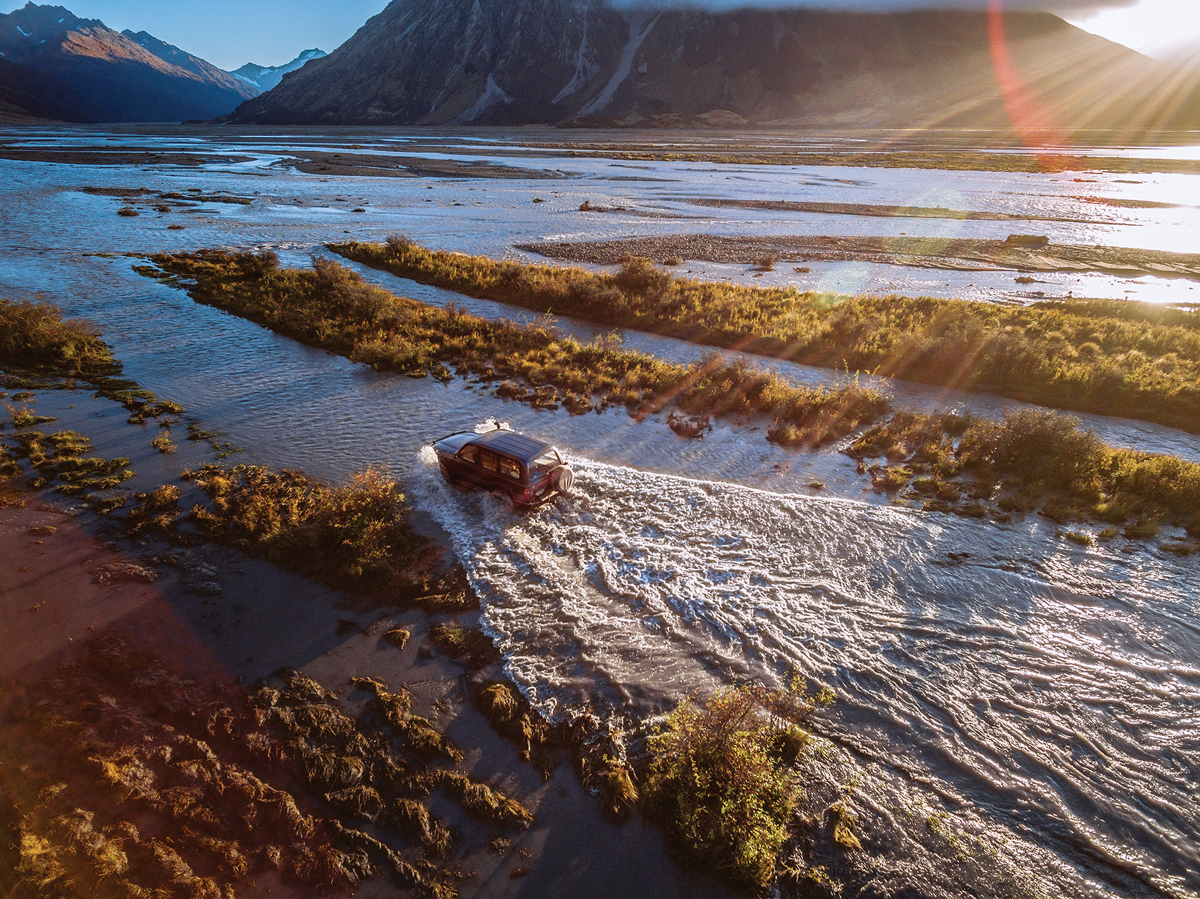
The country has been synonymous with a certain type of hunting for years, of course. Who among us hasn’t drooled over images of the country’s giant red stags, with antlers as thick and knobby as baroque banisters. But those magnum stags, along with other trophy antlered game, are products of high-fence estates. I was more interested in New Zealand’s free-ranging bounty, the endless numbers of fallow deer on the country’s big sheep stations and the imported alpine goats in the rugged national parks.
O’Brien, who runs media relations for Yeti—the cooler company—and who shares my affinity for high elevations, came up with the idea for the hunt, but his invitation came with a warning.
“We’d be sort of freelancing our way around the South Island,” he said. “This isn’t a trophy hunt.” There was no guarantee that we’d bring back any meat at all in our coolers.
But we’d hardly have to make our own way. O’Brien arranged for a mutual friend, Remi Warren, to guide us. Warren, who spends the autumn months hunting the mountains of the American West and guiding elk hunters in Montana, has a decade of off-seasons in New Zealand, where like a modern-day Strider of Tolkien lore, he ranges and explores the nation’s backcountry. His mentor and partner is Phil Wilson, a pioneer in sport hunting in New Zealand whose guiding business, NZ Hunts, is one of the oldest and most respected outfits in the country.
Warren recommended that we start our low-fence New Zealand adventure chasing fallow deer, which are native to the dry mountains of Lebanon and Syria, on the biggest sheep station on the South Island. Then we’d meet up with Wilson and hunt free-ranging stags, tahr, and chamois—petite, rock-clinging goats native to the European Alps—in the big, wild mountains that were the filming location for many of the epic scenes in the Lord of the Rings trilogy. Wilson would be our Gandalf. I guess that would make Ben and me Frodo and Sam Gamgee, with rifles instead of hiking staffs. Other members of our fellowship were photographer Ben Potter and Shane Dorian, a world-class surfer from Hawaii who bowhunts around the world when he’s not carving waves.
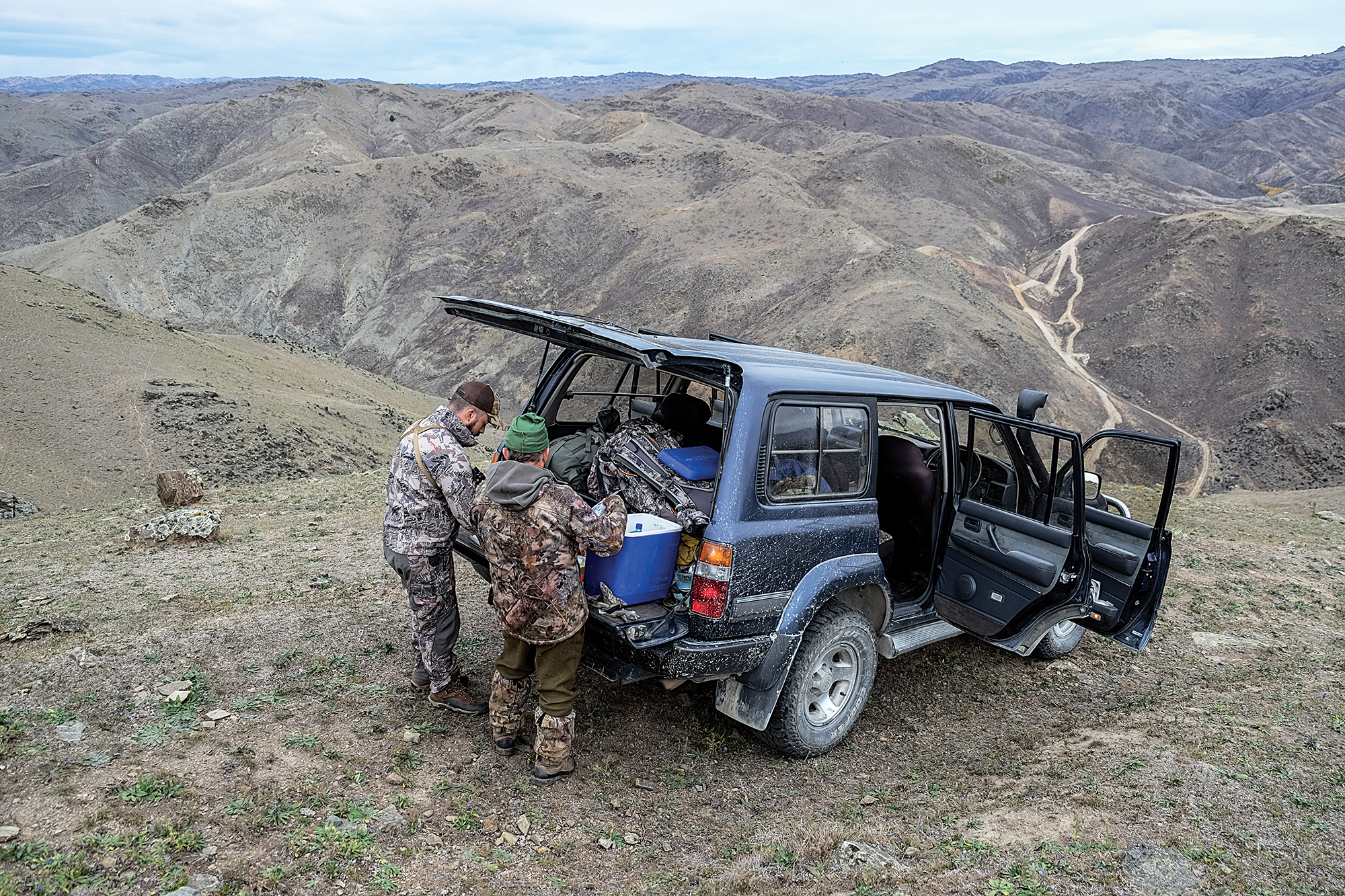
INTRODUCED NUISANCES
To understand New Zealand’s hunting culture, it’s useful to know that every land mammal here was introduced. The only native fauna of the island nation are birds, reptiles, amphibians, bugs, and fish, along with marine mammals like seals and whales. All the others—the famed New Zealand sheep and cattle, the red deer and feral goats, and the ubiquitous rabbits and possums—were brought here at some time or another for some purpose or another. And because they had no natural predators, every wild, free-ranging animal eventually becomes either an overpopulated nuisance to be shot or poisoned, or a form of livestock to be penned and husbanded.
Hunters are considered public servants in New Zealand, helping control populations of animals that otherwise would overrun the islands. There are no hunting seasons here and very few bag limits or other restrictions on hunting. Rifle suppressors, for instance, are ubiquitous; you can buy them in most hardware stores and gas stations. You can sell the meat, hides, and antlers from ungulates. Most restaurants have red deer on their menu, and there’s even a thriving market for the downy fleece of road-killed possums.
I got a first-hand look at the environmental effect of uncontrolled critters. Our first stop on the South Island was at the sheep station owned by Andrew and Jo Preston. Besides the townships of wild thyme and rippling herds of merino sheep, there was very little else on the range, which resembled the arid basin country of Nevada, or the bleaker parts of Tolkien’s Mordor. The station, so large that Andrew employs a helicopter to check on his sheep, had been badly overgrazed—by rabbits, said Andrew. At the height of the infestation in the middle of the last century, rabbits were so numerous that when they ran out of grass and brush to eat, they ate the wooden fenceposts.
For a generation, the station has employed “night shooters”—motorcycle-mounted sharpshooters who cruise the remote roads and trails with spotlights, killing every rabbit, feral cat, possum, and stoat that they shine. We ran into one of these night shooters as we returned to the station from a day of deer hunting. The shooter, G.B. Wigglesworth, said he was having a slow night; he had killed only 22 rabbits in his first hour of patrol. Back at the station, Andrew said that’s evidence that control efforts are working.
“Back in the day, they’d shoot 400 to 600 rabbits every night,” he told me. I calculated in my head—that’s easily more than 100,000 rabbits in a year.
THE CHASE FOR BELCHING BUCKS
“The closest thing I can compare fallow deer hunting to is hunting antelope in parts of Wyoming,” says Phil Wilson, who pronounces his first name as “Feel.” That’s precisely what it seems like. In our first days on the station, we drive to high lookouts, and then get out our optics to glass distant herds. Most have at least one mature buck, and because it’s the breeding season, the males are agitated, milling the does around and chasing younger bucks away.
Every few minutes a sound like a beer-drinker’s belch rips across the landscape. It’s burling, the roar of a rutting buck, and it’s often answered by a rival.
“Jurassic bullfrog” is how Wilson describes the roar of fallow deer. We follow the deepest burls to find the oldest, biggest bucks. Several times, we stalk in on a herd with a good buck, assess his antlers, and talk ourselves out of killing him. Warren and Dorian both shoot nice bucks with their bows. There seem to be endless numbers of deer, and while I am itching to join Wigglesworth for an evening of rabbit shooting, I also want to hold out for a whopper buck.
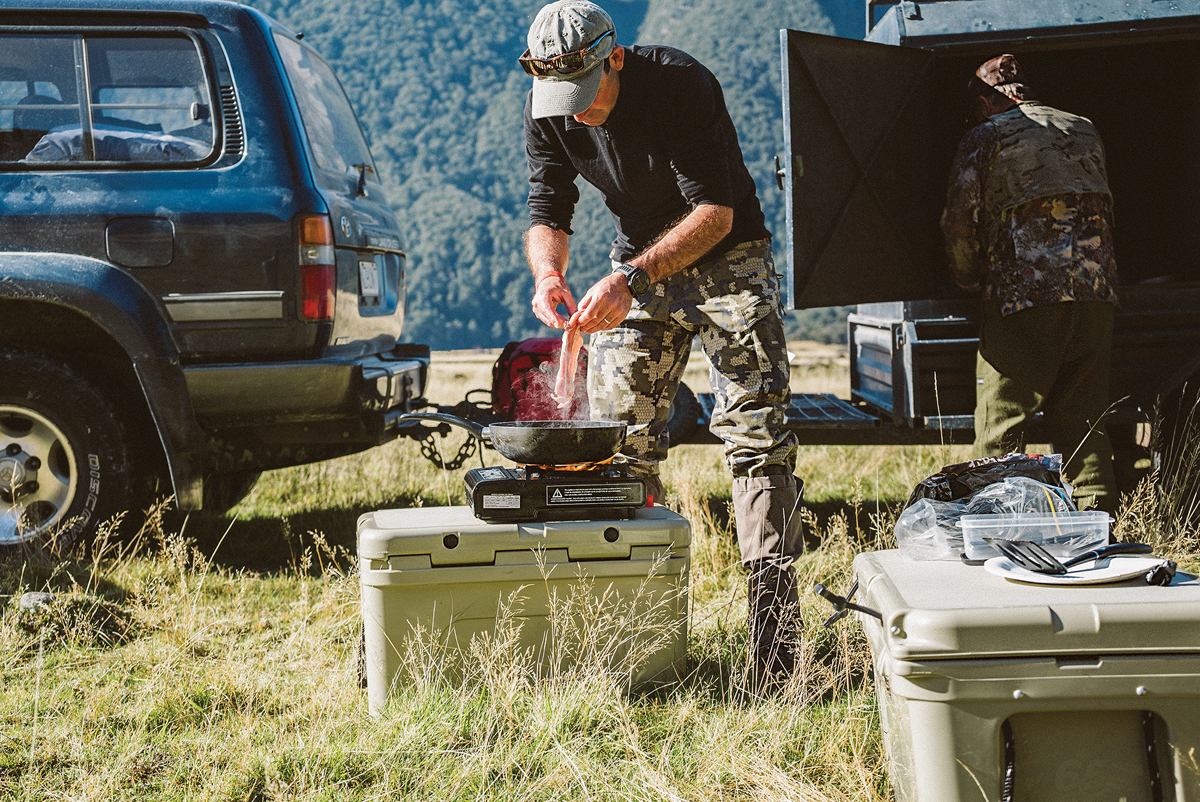
I get my chance one morning as we hike into a deep canyon, the sides of which are littered with the skeletons and skulls of feral goats. Goats, another introduced nuisance, are often baited into rocks and then shot from helicopters, their carcasses left to rot on the range. We saw a big buck in the area the previous day, and once we hear burling from the bottom of the canyon, we put the wind in our face and follow the sound, picking our way through goat boneyards.
I wasn’t sure what gun to bring on this trip but settled on Weatherby’s synthetic Mark V, chambered in 6.5/300 Wby. Mag. As I tuck in behind the rifle for a long shot across the canyon at the buck, I am happy for the flat-shooting rig, easily capable of making the quarter-mile shot.
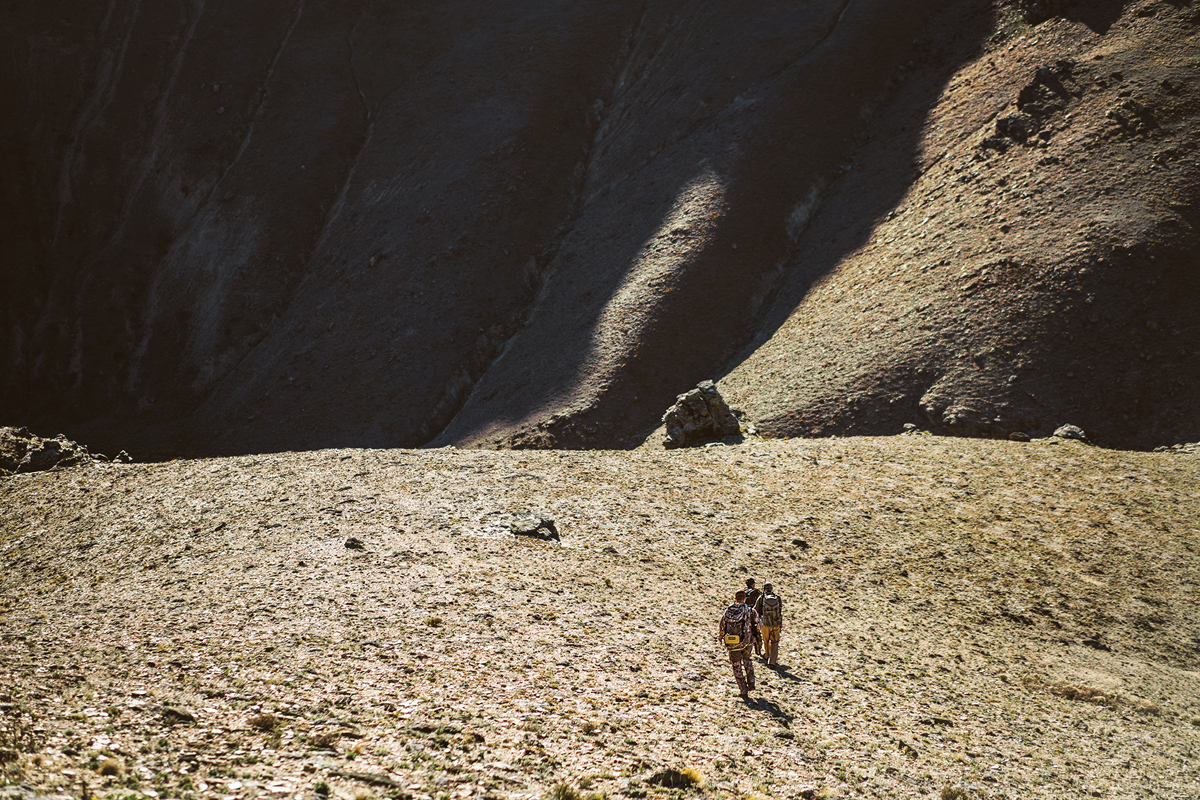
THE MISTY MOUNTAINS
Done with fallow deer (and the meat from our bucks stuffed into coolers), we tuck tents, sleeping bags, camp stoves, and food in our packs, pay our respects to Jo and Andrew, and drive northwest, toward the snow-capped mountains of the Southern Alps. The plan is to drive up a river valley and then either set up tents or bunk in one of the dozens of simple huts that the government maintains for hikers, hunters, and anyone else accessing the New Zealand backcountry. All of the land up here is public, and it’s wide open to almost any type of use except, as frequent signs remind us, woodcutting.
As we enter the mountain valley, the blacktop road turns to gravel, and then to dirt, and then the road disappears altogether at the edge of a swift river, slurried with suspended glacial silt.
“Out here, the river is the road,” says Warren, who fretted that the water might be too high and swift for our all-terrain pickups. Rain fell the previous night, and the river has risen a full foot. But the beauty of a watershed of rock and ice is that flood events don’t last long after the rain stops, and after a couple hours of waiting, the river has lowered enough to allow our advance. We drive straight up the rocky riverbed into one of the most stunning mountain valleys I’ve ever seen.
At its head, a complex of vivid blue-white glaciers hangs from the mountaintops. Below the snow line is a band of grass and boulders that Kiwis call “tussock.” And below that, a lush green forest falls down to the valley floor, which is cut with the serpentine river and carpeted with emerald meadows and bottle-green bogs. As we pitch our tents—the red-roofed hut we intended to reach is cut off by a particularly swift section of the river—we dance and prance like little boys, electrified to be in such a stunning playground, without a road or a fence or a power line in sight. I keep looking upward at the peaks, longing to explore the high country.
I get my chance that very afternoon. We split up, Remy taking Shane and Ben Potter with their bows, and Phil taking Ben O’Brien and me with our rifles. In my pack is enough gear to spend the night on the mountain, but as we enter the beech forest and begin a long slog straight up toward the tussock, I wish I had packed a rope, and that we had started earlier in the day.
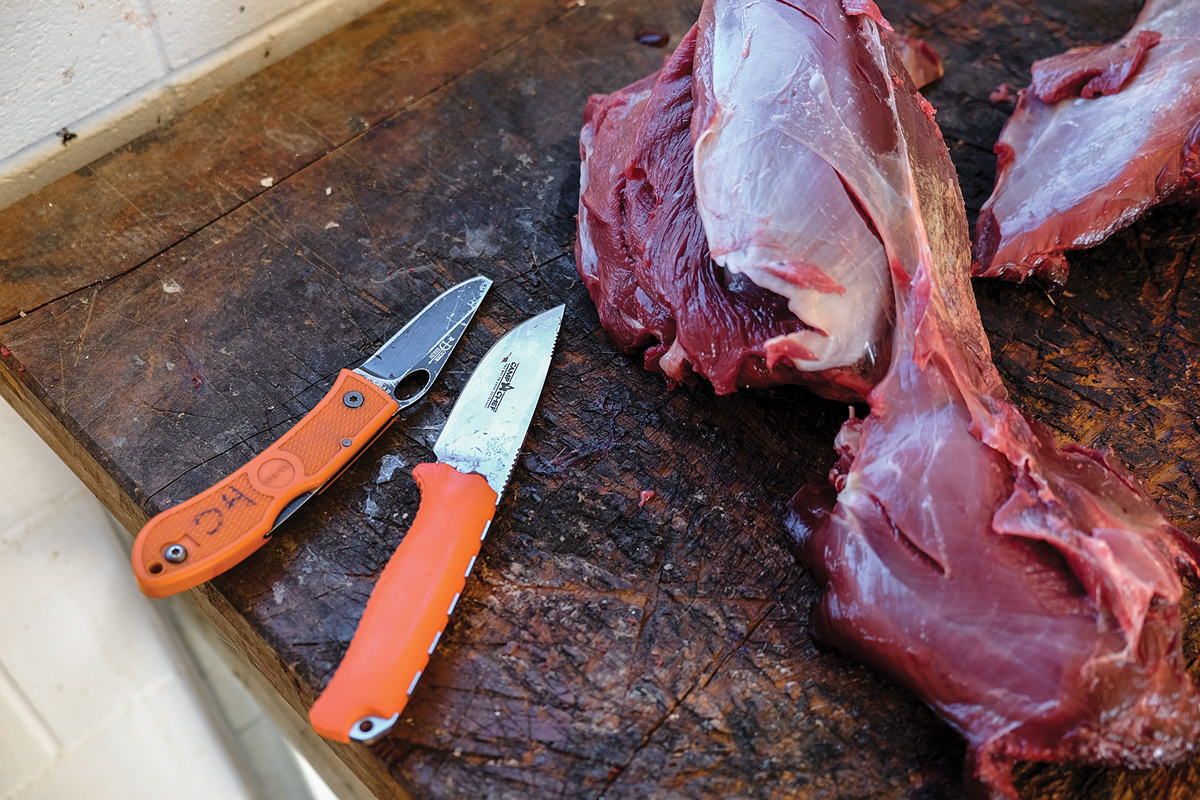
I figure I can normally hike about 1,250 feet of elevation in an hour, as long as I don’t have to do any technical climbing or make many lateral detours. But the way to the treeline here in the Southern Alps is sometimes straight up, so steep that I pull myself from one beech tree to the next. Our pace slows to 1,000 feet in an hour. It’s late afternoon by the time we enter the cirque, and the three of us start glassing the peaks.
“The bigger tahr bulls won’t come out of the rocks until last light,” Wilson says. “They’re hiding from the choppers.” Many trophy hunters come to New Zealand to kill a stag, but they often add a tahr or chamois to their package, boarding helicopters in the valleys and flying into the mountains to shoot wild goats. Not many hunters access the mountains the way we did—with our boots, from the bottom. Read more about tahr hunting New Zealand here.
“We’ll see if we can spot tahr first,” says Wilson, “then figure out if we can get to them before dark.”
Not long after Wilson makes that statement, I spot the blocky bull tahr picking his way out of the shadows. O’Brien whispers, “Sham-wah.” Though it sounds like a product in an infomercial, it’s the proper pronounciation for the name of the little fawn-brown goat he’s spotted grazing at the top of an avalanche chute about 700 yards above us. Wilson confirms it’s a young male. O’Brien defers to me. “Your call,” he whispers. It would be easy to slide to the base of the chute and make a long shot at the chamois. Or I could hold out for tahr, hoping others would emerge low enough on the mountain that we could make a play on them before dark. I waffle.
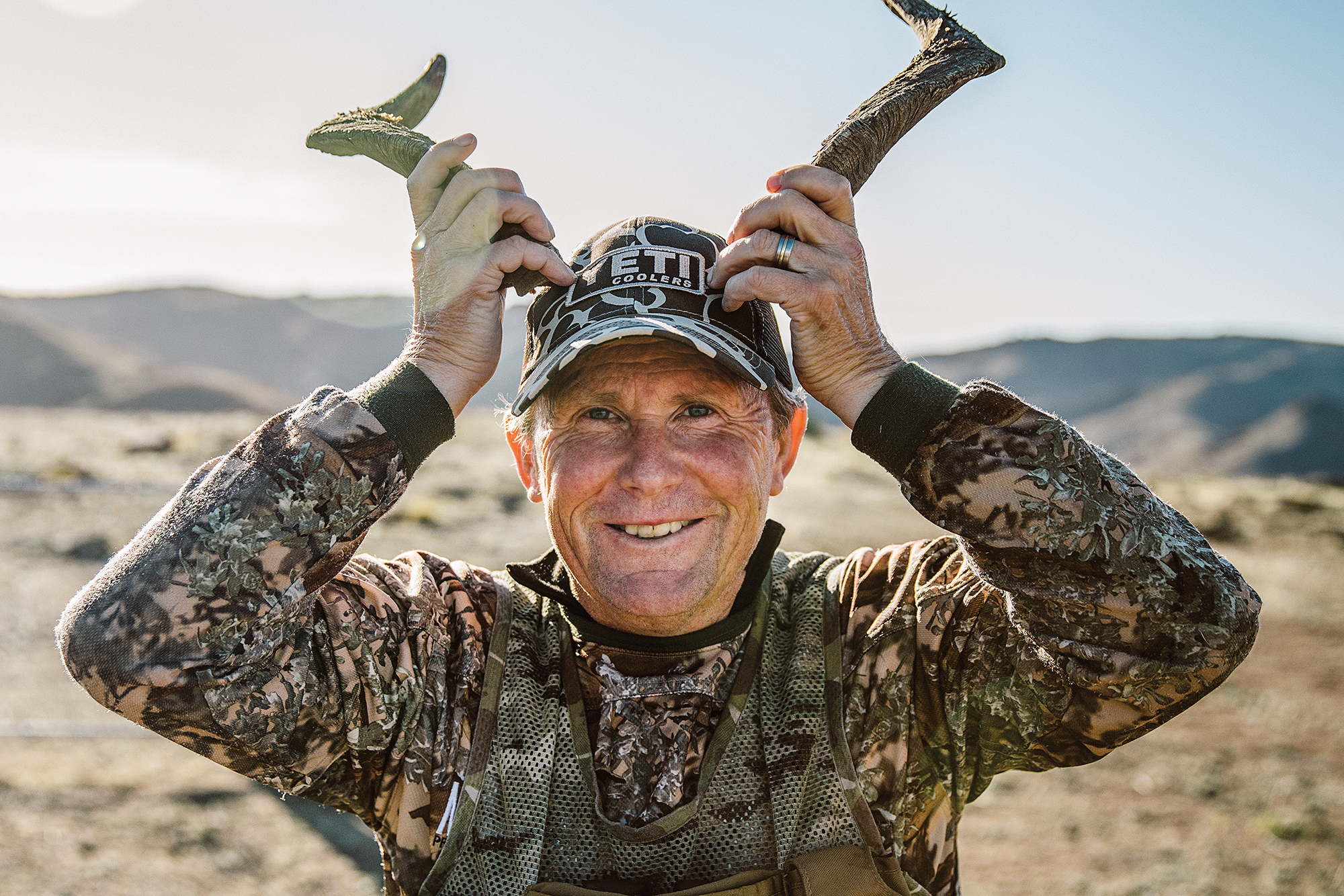
“I dunno. He’s sort of young,” I whisper. “He is right there. But a big old tahr would be such a cool trophy…”
In the end, I decide to keep waiting for tahr, and the sun sets on our opportunity. Late that night, when we finally stumble into our campsite, Warren is baffled. “Wait? You didn’t shoot a chamois when you had the chance? Do you know how few people actually hike into a chamois? Unbelievable!” Warren reports that his group spotted a big wild stag but couldn’t close in for a shot. Then he tells me he has hunted these mountains for a decade and has only a handful of encounters with chamois to show for it.
I slide into my sleeping bag fitful with the realization that I have violated a principle of mountain hunters: Always take the game that’s offered, because opportunity is so uncertain.
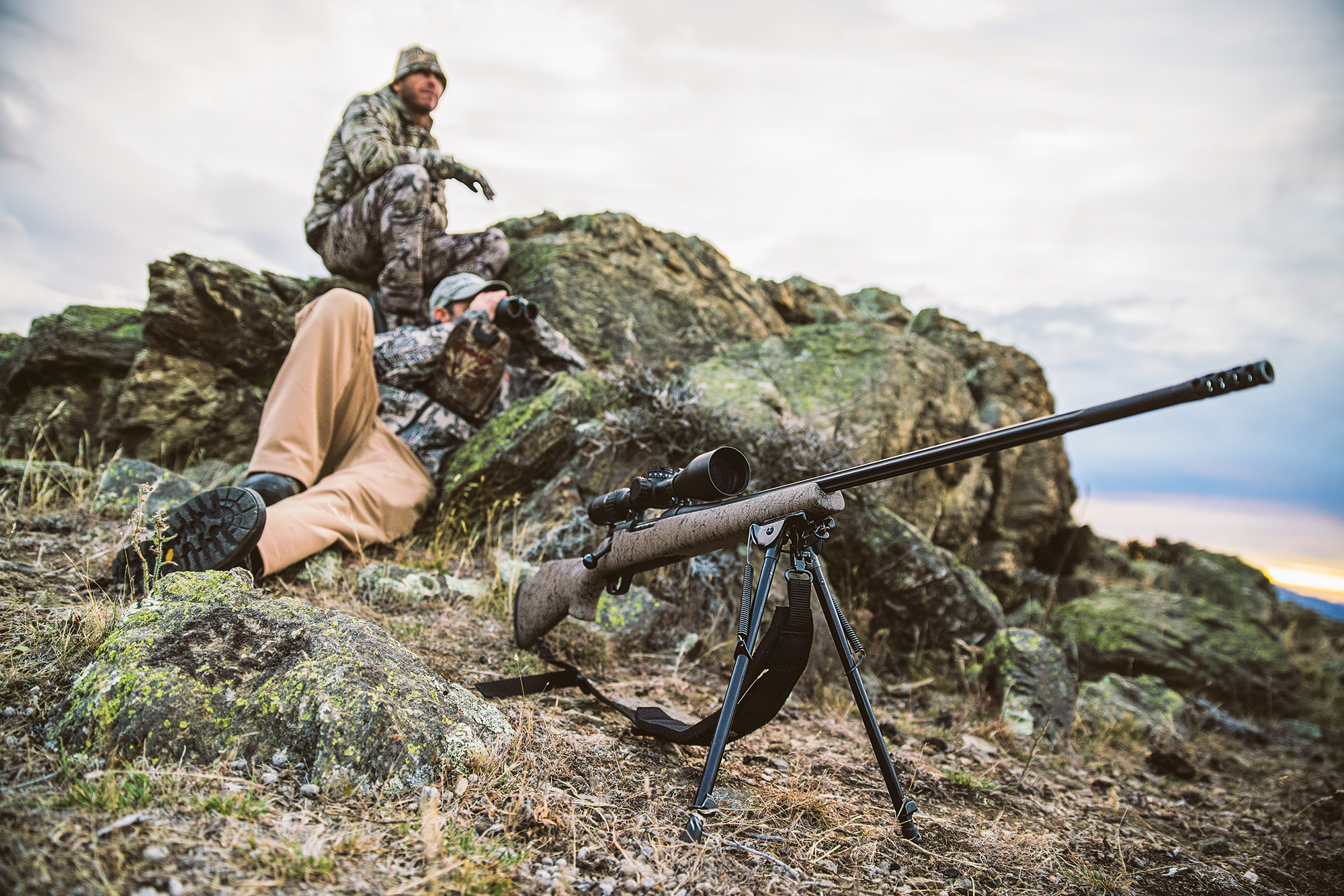
UNDER THE ROTORS
i cling to a chance for redemption. Wet weather is forecast for our valley, and in order to beat the rising river, we strike camp and drive out early the next morning. That day, our final in the country, we arrange for a helicopter pilot to fly us to the summit of the Southern Alps. It feels like cheating as the rotors lift us up and over the ground O’Brien and I had hiked so hard to gain yesterday.
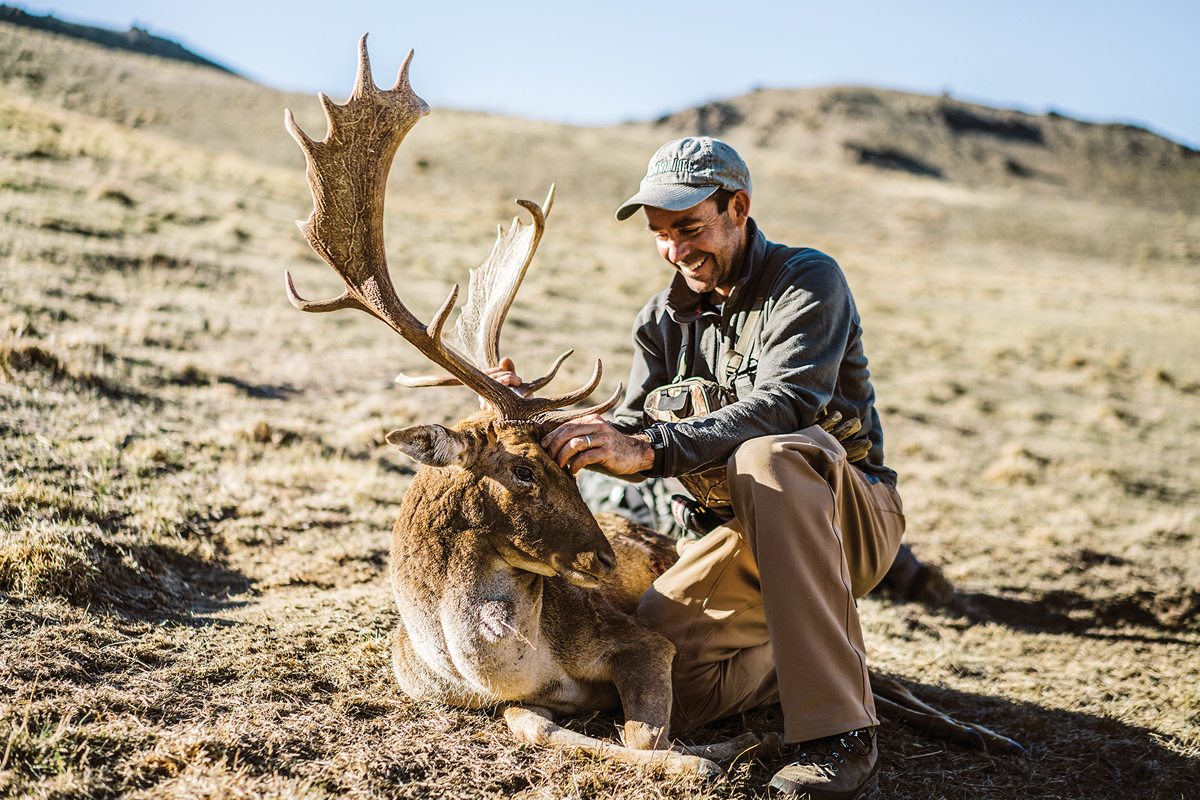
Weather forces us to set down in a marginal area, but I don’t care that we never hike to a tahr or chamois. The moody light, the sheer emerald walls of the alpine basin, and the chance to hike in new and different mountains is fulfilling enough. On the flight out, the weather breaks and the pilot takes us over the highest peaks of the Alps. We see endless snowfields and pristine glaciers, craggy mountains that vault right out of the South Pacific. As we bank around a spire, we flush a little band of chamois, which bound and dart across the tussock. The pilot wants to land so I can shoot one, but I wave him off.
Even if I never make it back to these misty mountains, I want to remember them on their terms, every strenuous step and every wild animal earned with effort. That’s the mark of a mountain hunter, no matter where on earth he hunts.

